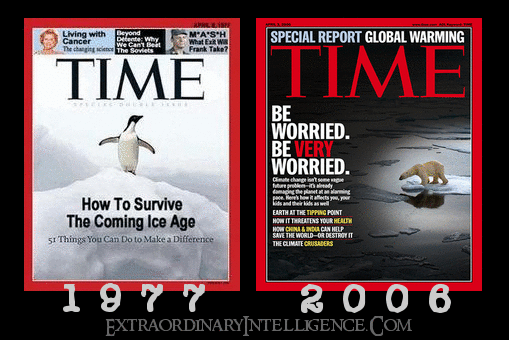
I’m far from a political moderate, but I’ve been tagged as a “lukewarmer” in the climate wars. That’s because, at least from a theoretical perspective, it’s hard (but not impossible) for me to imagine that increasing CO2 won’t cause some level of warming.
I would remind folks that the NASA AIRS instrument on the Aqua satellite has actually measured the small decrease in IR emission in the infrared bands affected by CO2 absorption, which they use to “retrieve” CO2 concentration from the data. Less energy leaving the climate system means warming under almost any scenario you can think of. Conservation of energy, folks. It’s the law.
But I’ve been troubled for quite a while by those “skeptics” (you know who you are) who are forecasting cooling in our future. Not that it couldn’t happen, but are you ready to be “debunked” when we see continued slow warming?
The debate will then be about how the skeptics who predicted cooling were wrong. Warming continues. The IPCC was right. There is obvious danger in that becoming the narrative.
Some of us have been trying to explain that there is a big difference between weak (or even modest) warming, and catastrophic warming. The former is probably beneficial, especially when you factor in the benefits of more CO2 on photosynthesis. I was taught this lesson by Pat Michaels who, after my talk at a Heartland conference, correctly rebuked me for publicly implying that modest warming would be evidence the IPCC was correct and we skeptics were wrong.
Pat was right. Some level of warming can probably be expected, but just how much makes a huge difference. Lindzen and I and a few other researchers in the field think the IPCC models are simply too sensitive, due to positive feedbacks that are either too strong, or even have the wrong sign. But we still believe more CO2 should cause some level of warming.
If the current lack of warming really is due to a natural cooling influence temporarily canceling out CO2-induced warming, what happens when that cooling influence goes away? We are going to see rather rapid warming return…but nowhere near the levels of warming predicted by most of the IPCC climate models.
It’s fascinating to me that the predictions we see in the media are almost bimodal…either catastrophic warming, or another ice age. Of course, the news cycle enjoys predictions of catastrophe (see the Time magazine covers, above).
But sometimes it seems like we global warming moderates are getting drowned out by the extremists.
(And for those who are ready to snark me for my “extremist” political views, I will only say that it’s a sad day when supporting the U.S. Constitution is viewed as “extremist”.)

 Home/Blog
Home/Blog



